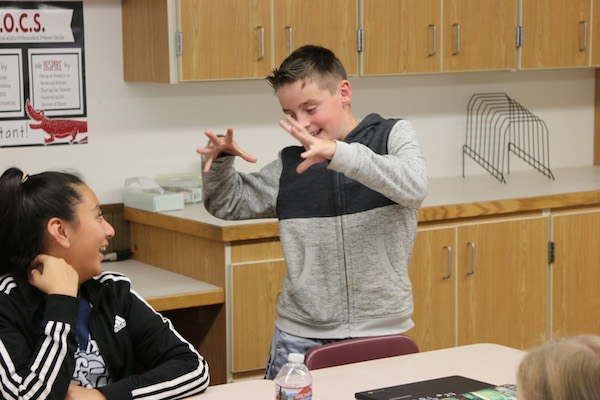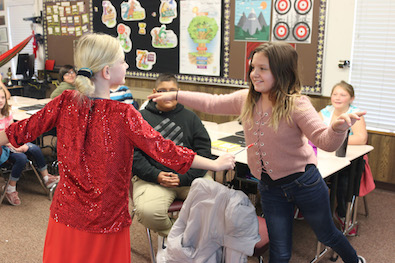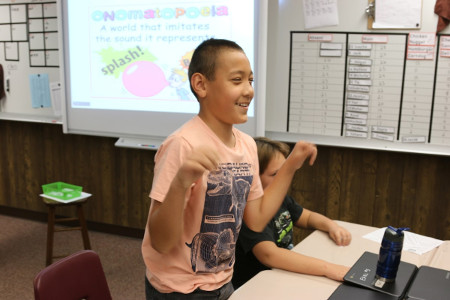SUBJECTS
GRADE
Show Results
Just the Right Word

Lesson Summary
- Demonstrate vocal expression utilizing onomatopoetic and sensory words.
- Demonstrate emotional expression using punctuation as cues.
Lesson Plan and Procedure
Lesson Key Facts
- Grade(s): 5
- Subject(s): Drama, English Language Arts
- Duration of lesson: 40 minutes
- Author(s): Teresa Dayley Love
Preparation
Make sure you know the definitions of the following words:
- Razzle-dazzle
- Glitter
- Hominy
- Succotash
- Papoose
- Muckamuck
Warm-Up/Hook
Ask a girl volunteer to wear a costume.
Teacher: I call this red dress the razzle-dazzle dress. Here’s a poem about a girl in a red dress.
Read “Whiskers Meets Polly” by Michael Stillman, which should be written on the board or on a poster so the class can follow along as you read.
Reflection
Once you have read the piece, let the volunteer help you. Give her a wand.
Teacher: Now, when she points this shiny wand, we will all say the word razzle-dazzle!
Encourage the students to say the word in a way that depicts the word meaning, so that their voices express the personality of the word. Have the students do this several times, trying out new ways to say the word. Now have the whole class reread the poem with you, characterizing their words. Repeat several times, encouraging the students to articulate and project without yelling.
Introduction
Introduce the students to the poem “My Favorite Word” by Lucia and James L. Hymes, Jr. Read it aloud while the children listen. Hold a short discussion about the poem: the imagery, the mood, the speaker, the message, and the structure. After, have the students identify the punctuation in the poem and its purpose in the poem.
Teacher: Poetry has different rules than the ones you are expected to use to write in your journals. In poetry, poets shape their poems as a clue to help us understand how they want us to read and understand their work.
Teacher: Do you like candy? Well, reach into your pretend pocket and pull out your favorite type of candy.
Give the children specific instructions to pantomime opening the wrapper, encouraging them to show you the difference between the candies (e.g., opening a lollipop vs. opening a bag of M&Ms). Don’t let them pretend to eat them yet. Instead, ask them what they should do if there is a guest.
Teacher: Go ahead and ask me if I want some of your candy.
The children will ask, “Do you want some candy?” Have them repeat the question to you, so they can hear the inflection. Then tell them to put all the words in that question into just two words, “Some candy?” as it is in the poem. Let the students “eat” their candy while being specific in their pantomiming.
Have the students “beg” to take you to the movies (like in the poem). Have the students ask in just two words, “A movie?” with the same energy. Refer back to the poem, and help the students identify ways they can express the poet’s intent, now that they know how the poem is written. Have the students read the poem all together, focusing on expression and intent.



Instruction/Rehearsal
Show and read the poem “Where Do These Words Come From?” by Charles Pomerantz.
Have the students note the punctuation. Read the poem quickly. With a displayed copy of the poem, have the students come up and change the punctuation wherever they like: they can draw a comma, a question mark, a period, or an exclamation point next to whatever word they choose. Have the students read the poem with the new punctuation. Do this a few times with different students, and read the poem when there is a change.
Introduce the term onomatopoeia: words that sound like what they are describing or that imitate the meaning. Hand each student (or pair of students) a paper with an onomatopoeia written on it, such as bang, boom, gargle, slip, or swoop. Give them time to practice how they will perform it for the class without saying the word.



Activity/Performance
Have the students perform their onomatopoeias, and perhaps have the students guess what each word is. 
Conclusion
Ask the students to name the new words they learned today. Ask them to recap the different types of punctuation and how that changed the message in the writing and the way they read/acted out the words. Ask them to name their favorite poem of the lesson and explain why it’s their favorite.
Optional Follow-Up Activities:
“Where Do These Words Come From?” uses all Native American words. Have the students research other words contributed by Native Americans and write their own poems in a similar fashion.
Have students read or watch a production of “Alice’s Adventures in Wonderland.” Tell the students that when the author, Lewis Carroll, couldn’t find the right word, he would make up his own. Share the story “Jabberwocky.” Read the story with expression, modeling and reinforcing what the students have just learned, and have them keep a running list of “created” words. Draw definitions to these made-up words.
Have students take a familiar piece of reading material and change the meaning using punctuation.
Learning Objectives
- Determine a theme of a story, drama, or poem from text details.
- Determine how the speaker in a poem reflects upon a topic.
- Use punctuation to separate items.
- Summarize a text.
- Develop imagination.
- Respond in character during a scene.
- Communicate meaning through body and voice.
- Demonstrate audience skills.
Utah State Board of Education Standards
This lesson can be used to meet standards in many grades and subject areas. We will highlight one grade’s standards to give an example of application.
5th Grade English Language Arts
Standard 5.R.6: Determine the theme or main idea of a text including those from diverse cultures and how it is conveyed through particular details and summarize the text. (RL & RI)
Standard 5.R.4: Read grade-level text* with accuracy and fluency to support comprehension. (RL & RI)
5th Grade Drama
Standard 5.T.CR.1: Develop imagination to create artistic ideas and work.
Standard 5.T.P.3: Observe, listen, and respond in character to other actors throughout a scripted or improvised scene.
Standard 5.T.P.4: Communicate meaning using the body through space, shape, energy, and gesture.
Standard 5.T.P.5: Communicate meaning using the voice through volume, pitch, tone, rate, and clarity.
Standard 5.T.R.1: Demonstrate audience skills of observing attentively and responding appropriately.
Equipment and Materials Needed
- Poetry selections prepared for students to read (on a large poster, whiteboard, PowerPoint, etc.)
- Any appropriate prop or costume
- A sparkly wand
- Any pictures or other visuals that help illustrate vocabulary
Additional Resources
- “Native American Contributions to the U.S.”: http://blog.nativepartnership.org/history-of-native-american-day-part-2/
- Drama resources for teachers: http://education.byu.edu/arts/resources/drama
- http://www.almostanauthor.com/understanding-poetry-5-questions-to-ask/
- https://www.edweek.org/tm/articles/2012/01/14/tln_curran_poetry.html
Image References
Images 1–9: James Huston.

www.education.byu.edu/arts/lessons
 Download
Download